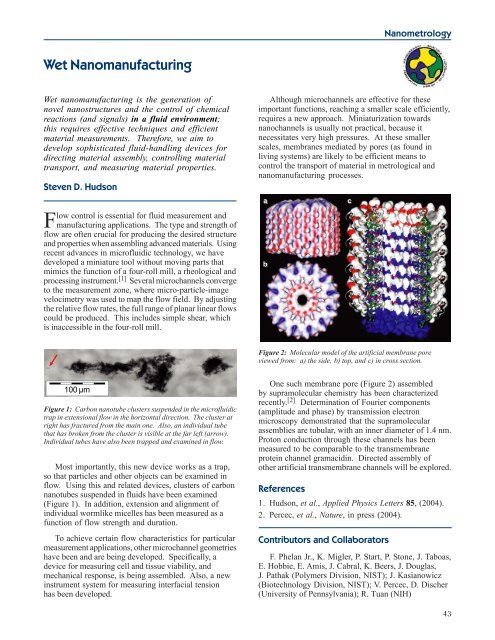Materials Science and Engineering Laboratory FY 2004 ... - NIST
Materials Science and Engineering Laboratory FY 2004 ... - NIST
Materials Science and Engineering Laboratory FY 2004 ... - NIST
You also want an ePaper? Increase the reach of your titles
YUMPU automatically turns print PDFs into web optimized ePapers that Google loves.
Wet Nanomanufacturing<br />
Wet nanomanufacturing is the generation of<br />
novel nanostructures <strong>and</strong> the control of chemical<br />
reactions (<strong>and</strong> signals) in a fluid environment;<br />
this requires effective techniques <strong>and</strong> efficient<br />
material measurements. Therefore, we aim to<br />
develop sophisticated fluid-h<strong>and</strong>ling devices for<br />
directing material assembly, controlling material<br />
transport, <strong>and</strong> measuring material properties.<br />
Steven D. Hudson<br />
Flow control is essential for fluid measurement <strong>and</strong><br />
manufacturing applications. The type <strong>and</strong> strength of<br />
flow are often crucial for producing the desired structure<br />
<strong>and</strong> properties when assembling advanced materials. Using<br />
recent advances in microfluidic technology, we have<br />
developed a miniature tool without moving parts that<br />
mimics the function of a four-roll mill, a rheological <strong>and</strong><br />
processing instrument. [1] Several microchannels converge<br />
to the measurement zone, where micro-particle-image<br />
velocimetry was used to map the flow field. By adjusting<br />
the relative flow rates, the full range of planar linear flows<br />
could be produced. This includes simple shear, which<br />
is inaccessible in the four-roll mill.<br />
Figure 1: Carbon nanotube clusters suspended in the microfluidic<br />
trap in extensional flow in the horizontal direction. The cluster at<br />
right has fractured from the main one. Also, an individual tube<br />
that has broken from the cluster is visible at the far left (arrow).<br />
Individual tubes have also been trapped <strong>and</strong> examined in flow.<br />
Most importantly, this new device works as a trap,<br />
so that particles <strong>and</strong> other objects can be examined in<br />
flow. Using this <strong>and</strong> related devices, clusters of carbon<br />
nanotubes suspended in fluids have been examined<br />
(Figure 1). In addition, extension <strong>and</strong> alignment of<br />
individual wormlike micelles has been measured as a<br />
function of flow strength <strong>and</strong> duration.<br />
To achieve certain flow characteristics for particular<br />
measurement applications, other microchannel geometries<br />
have been <strong>and</strong> are being developed. Specifically, a<br />
device for measuring cell <strong>and</strong> tissue viability, <strong>and</strong><br />
mechanical response, is being assembled. Also, a new<br />
instrument system for measuring interfacial tension<br />
has been developed.<br />
Nanometrology<br />
Although microchannels are effective for these<br />
important functions, reaching a smaller scale efficiently,<br />
requires a new approach. Miniaturization towards<br />
nanochannels is usually not practical, because it<br />
necessitates very high pressures. At these smaller<br />
scales, membranes mediated by pores (as found in<br />
living systems) are likely to be efficient means to<br />
control the transport of material in metrological <strong>and</strong><br />
nanomanufacturing processes.<br />
Figure 2: Molecular model of the artificial membrane pore<br />
viewed from: a) the side, b) top, <strong>and</strong> c) in cross section.<br />
One such membrane pore (Figure 2) assembled<br />
by supramolecular chemistry has been characterized<br />
recently. [2] Determination of Fourier components<br />
(amplitude <strong>and</strong> phase) by transmission electron<br />
microscopy demonstrated that the supramolecular<br />
assemblies are tubular, with an inner diameter of 1.4 nm.<br />
Proton conduction through these channels has been<br />
measured to be comparable to the transmembrane<br />
protein channel gramacidin. Directed assembly of<br />
other artificial transmembrane channels will be explored.<br />
References<br />
1. Hudson, et al., Applied Physics Letters 85, (<strong>2004</strong>).<br />
2. Percec, et al., Nature, in press (<strong>2004</strong>).<br />
Contributors <strong>and</strong> Collaborators<br />
F. Phelan Jr., K. Migler, P. Start, P. Stone, J. Taboas,<br />
E. Hobbie, E. Amis, J. Cabral, K. Beers, J. Douglas,<br />
J. Pathak (Polymers Division, <strong>NIST</strong>); J. Kasianowicz<br />
(Biotechnology Division, <strong>NIST</strong>); V. Percec, D. Discher<br />
(University of Pennsylvania); R. Tuan (NIH)<br />
43

















